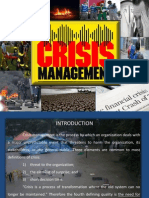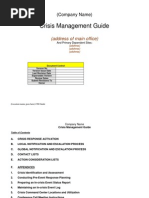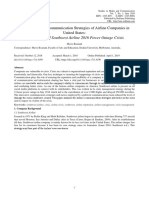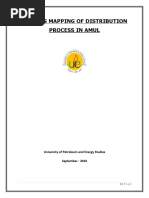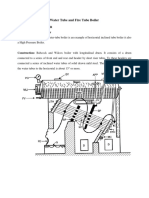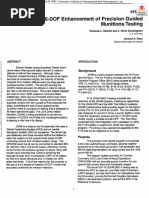The 6 Phases of CM
The 6 Phases of CM
Uploaded by
ahmed javedCopyright:
Available Formats
The 6 Phases of CM
The 6 Phases of CM
Uploaded by
ahmed javedOriginal Title
Copyright
Available Formats
Share this document
Did you find this document useful?
Is this content inappropriate?
Copyright:
Available Formats
The 6 Phases of CM
The 6 Phases of CM
Uploaded by
ahmed javedCopyright:
Available Formats
LECTURE 13
CRISIS PHASES
The 6 Phases of CM
Mitroff offers a five-stage model for crisis management: “(1) signal detection, seek to
identify warning signs and take preventative measures; (2) probing and prevention,
active search and reduction of risk factors; (3) damage containment, crisis occurs and
actions taken to limit its spread; (4) recovery, effort to return to normal operations;
and (5) learning, people review the crisis management effort and learn from it.”
(1) Signal detection
Monitoring and heeding of early warning signals that point to the possible
occurrence of a crisis. The explosion of the space shuttle Challenger is a prime
example of a crisis whose early warning signals were ignored. The Report of the
President's Commission on the Space Shuttle Accident uncovered a comprehensive
trail of memos before the event clearly explaining that the O-ring was improperly
designed and hence could cause a catastrophic failure of the shuttle.
The difficulty, of course, is that organizations are bombarded with signals of all kinds.
However, it has been found that organizations that are crisis prepared make a point
of constantly probing and scrutinizing their operations and management structure
for warnings of potential crises. In other words, they do not leave the detection of
important signals to chance. Instead, they put in place mechanisms to increase the
chances of early detection.
(2) preparation/prevention/probing
Doing as much as possible to avoid crises and to prepare better for those that still
manage to occur. This phase does not imply that all crises can be prevented; instead,
it emphasizes that the adage "if it isn’t broke, don't fix it" has no place in CM.
Those organizations that can be classified as crisis prone exhibit a very different
"mind-set" from those that can be classified as crisis prepared. As in the phase of
signal detection, preparation/prevention/probing in crisis-pre-pared organizations is
the careful and constant probing of operations and management structures for
potential "breaks and cracks" before they become too big to "fix." An example of a
lack of attention to preparation/ prevention/ probing is Union Carbide's chemical
explosion in its Bhopal, India, plant, during which thousands of people died because
they had not previously been made aware of a basic safety response (i.e., covering
one's nose and mouth with rags to avoid ingesting methyl isocyanate gas).
(3) Damage containment
Intended to keep a crisis from spreading to other, uncontaminated parts of an
organization or its environment. A tragic example is the environmental costs of the
Exxon Valdez oil spill, which were intensified by both poor damage containment
mechanisms, such as inefficient oil-skimming equipment, and ineffectual damage
containment activities, as well as the time lost in communicating among divisions of
Exxon. A critical point regarding damage containment mechanisms and activities is
that they are virtually impossible to invent during a crisis.
Rather, effective CM requires the continued development and testing of CM
capabilities before a crisis. In short, effective CM is proactive, not reactive.
(4) Business recovery
During the recovery phase, crisis-prepared organizations implement short-term and
long-term business recovery programs to facilitate the resumption of normal
business operations. Programs designed for this purpose include the identification of
minimal services and procedures needed to resume business, the reassignment of
people to new jobs, and the designation of alternative operating sites.
(5) Learning
Reflection on and examination of the lessons that have been learned from the
organization's own crisis experiences, as well as those of other organizations. Many
organizations gloss over this phase because of the mistaken belief that an
examination of the past will "only reopen old wounds." But almost exactly the
opposite has been found to be true. Following a crisis or near disaster, crisis-
prepared organizations examine and compare the factors that enabled them to
perform well with those that impeded their CM performance, without assigning
blame. By contrast, crisis-prone organizations emphasize finding blame instead of
learning lessons.
A valid CM audit assesses how well an organization is performing on each of these
phases. (The scoring system used is a relatively simple one. Every yes that an
organization gives to a particular component adds a one to its score. In comparison,
the scoring system for the preceding variable types is much more complicated and is
explained in Chapter 5.
http://cpor.org/phasescrisis.cgi
You might also like
- Crisis ManagementDocument6 pagesCrisis Managementcool_mani11No ratings yet
- A Project Report On Crisis Final 200923Document80 pagesA Project Report On Crisis Final 200923poooma100% (1)
- Lea Chapter 1 2 Esma WieserDocument6 pagesLea Chapter 1 2 Esma WieserWieser EsmaNo ratings yet
- Mba VUCA RecordDocument27 pagesMba VUCA RecordgutsybeingNo ratings yet
- What Is A CrisisDocument18 pagesWhat Is A Crisispravinpawar28No ratings yet
- Preparedness For A Disaster 1: Running HeadDocument7 pagesPreparedness For A Disaster 1: Running HeadBest EssaysNo ratings yet
- Crisis Management Is The Process by Which An Organization Deals With A Major Unpredictable Event That Threatens To Harm The OrganizationDocument4 pagesCrisis Management Is The Process by Which An Organization Deals With A Major Unpredictable Event That Threatens To Harm The OrganizationAssan Abdraimov100% (1)
- Crisis Management PhasesDocument12 pagesCrisis Management PhasesJesselle Ann IbanezNo ratings yet
- Emergency Response DrillDocument8 pagesEmergency Response DrillMARSHELLA PONTILLONo ratings yet
- Crisis Management GDDocument2 pagesCrisis Management GDSoumen SauNo ratings yet
- Disaster Recovery - EditedDocument9 pagesDisaster Recovery - EditedalexNo ratings yet
- Crisis Management - EDocument28 pagesCrisis Management - EMuzany Suradi100% (3)
- Crisis ManagementDocument24 pagesCrisis ManagementasmashNo ratings yet
- BMCPR 412 Crisis Management in Communication and Public Relations NotesDocument34 pagesBMCPR 412 Crisis Management in Communication and Public Relations Notesnatasha mukukaNo ratings yet
- Dynamics of Crisis CommunicationDocument3 pagesDynamics of Crisis CommunicationTahir RasheedNo ratings yet
- XIX Paper 59Document15 pagesXIX Paper 59saminasritnNo ratings yet
- Toyota in Crisis: Denial and Mismanagement: Victor L. Heller and John R. DarlingDocument10 pagesToyota in Crisis: Denial and Mismanagement: Victor L. Heller and John R. DarlingYasir ChhipaNo ratings yet
- Crisis Management and CommunicationsDocument18 pagesCrisis Management and CommunicationsGeorge ChaloutsosNo ratings yet
- detail note on crisis managementDocument5 pagesdetail note on crisis managementakch.8191No ratings yet
- 03 Coombs Crisis ManagementDocument15 pages03 Coombs Crisis ManagementRoxana IstrateNo ratings yet
- Crisis ManagementDocument23 pagesCrisis ManagementLauren Gail75% (4)
- CS&a Journal of CommDocument8 pagesCS&a Journal of CommGabriel BernalNo ratings yet
- By W. Timothy Coombs, PH.D October 30, 2007: Crisis Management and CommunicationsDocument16 pagesBy W. Timothy Coombs, PH.D October 30, 2007: Crisis Management and CommunicationsdeeaNo ratings yet
- Running Head: Crisis Communication 1Document6 pagesRunning Head: Crisis Communication 1suljo atlagicNo ratings yet
- XIX Paper 59Document15 pagesXIX Paper 59DarmawanNo ratings yet
- Chapter 3 (Part A) - Crisis ManagementDocument48 pagesChapter 3 (Part A) - Crisis Management孟德壮No ratings yet
- Crisis ManagementDocument9 pagesCrisis ManagementMithesh Phadtare100% (2)
- Understand The Risk Posed by ManagementDocument15 pagesUnderstand The Risk Posed by Managementdutru2003No ratings yet
- Crisis Planning: Increasing Effectiveness, Decreasing DiscomfortDocument6 pagesCrisis Planning: Increasing Effectiveness, Decreasing DiscomfortbaynoliNo ratings yet
- Safety First (Chapter15)Document19 pagesSafety First (Chapter15)Hk Lorilla QuongNo ratings yet
- Crisis Management Paper StudyDocument17 pagesCrisis Management Paper StudyAmr Abd RaboNo ratings yet
- CrisisDocument6 pagesCrisishabibi 101No ratings yet
- 3.2 Crisis Management MAC 2020Document53 pages3.2 Crisis Management MAC 2020rafiah bazlaaNo ratings yet
- Communication CrisisDocument6 pagesCommunication Crisisnadia rafithaNo ratings yet
- Mba Crisis Management NotesDocument14 pagesMba Crisis Management NotesChauhan Neelam100% (1)
- Crisis CommunicationDocument12 pagesCrisis CommunicationstrawbrollyNo ratings yet
- Crisis ManualDocument69 pagesCrisis ManualNtinos DedesNo ratings yet
- TASK 1 What A Crisis and What Is Crisis Communications-1Document9 pagesTASK 1 What A Crisis and What Is Crisis Communications-1LizNo ratings yet
- How To Create An Emergency Response Plan - MHA ConsultingDocument10 pagesHow To Create An Emergency Response Plan - MHA ConsultingRamon JaramilloNo ratings yet
- Accident ReportingDocument26 pagesAccident ReportinggerryfmarrNo ratings yet
- Summative Assessment Output On Crisis ManagementDocument8 pagesSummative Assessment Output On Crisis Managementjc segismundoNo ratings yet
- FIN 4345 - Risk ControlDocument10 pagesFIN 4345 - Risk ControlAshfaak MahirNo ratings yet
- Course LessonsDocument36 pagesCourse Lessonsmanuel pasamonteNo ratings yet
- Crisis Management 2Document14 pagesCrisis Management 2Richmond CandidoNo ratings yet
- Akshay K Samy ProjectDocument75 pagesAkshay K Samy ProjectAsif M sainudheenNo ratings yet
- Guide Near Miss Reporting Public ConsultDocument11 pagesGuide Near Miss Reporting Public ConsultLew MingNo ratings yet
- Disaster ManagementDocument6 pagesDisaster ManagementDaggy KiddNo ratings yet
- MS - KEYWORD DISPUTE-RESOLUTION-and-CRISISDocument30 pagesMS - KEYWORD DISPUTE-RESOLUTION-and-CRISISRea Erandio BalosoNo ratings yet
- Crisis ManagementDocument17 pagesCrisis ManagementMasitala PhiriNo ratings yet
- Challenges in Implementing Enterprise Risk ManagementDocument14 pagesChallenges in Implementing Enterprise Risk ManagementDarshan KmNo ratings yet
- Crisis ManagementDocument11 pagesCrisis ManagementKYLE CULLANTESNo ratings yet
- Risis Anagement: Compile by Bulan APRIL 2018Document18 pagesRisis Anagement: Compile by Bulan APRIL 2018imran hafizNo ratings yet
- CS Risk and Crisis Management FinalDocument62 pagesCS Risk and Crisis Management FinaldangermanNo ratings yet
- Chaos, Solitons and Fractals: Long Zhang, Lihong WangDocument8 pagesChaos, Solitons and Fractals: Long Zhang, Lihong WangAnas TariqNo ratings yet
- All Accident Are IncidentDocument6 pagesAll Accident Are IncidenttemterNo ratings yet
- Risk Management Using Failure Mode and Effect Analysis (FMEA)From EverandRisk Management Using Failure Mode and Effect Analysis (FMEA)No ratings yet
- Analysing Crisis Communication Strategies of AirliDocument10 pagesAnalysing Crisis Communication Strategies of Airliahmed javedNo ratings yet
- Assignment: Haider Mir (023) Muhammad Saad Javed Awan (021) Abdullah Qureshi (026) SAFI BAIG (018) Swot AnaysisDocument1 pageAssignment: Haider Mir (023) Muhammad Saad Javed Awan (021) Abdullah Qureshi (026) SAFI BAIG (018) Swot Anaysisahmed javedNo ratings yet
- Presentation E Commerce: Apps For Every Thing, Apps of EcosystemDocument10 pagesPresentation E Commerce: Apps For Every Thing, Apps of Ecosystemahmed javedNo ratings yet
- POM Presentation Chapter #4 Ahmed Javed (FA18-BBA-024)Document45 pagesPOM Presentation Chapter #4 Ahmed Javed (FA18-BBA-024)ahmed javedNo ratings yet
- What Is Rakuten?: The CompanyDocument7 pagesWhat Is Rakuten?: The Companyahmed javedNo ratings yet
- Green Hydrofonic FodderDocument3 pagesGreen Hydrofonic FodderMamo TolessaNo ratings yet
- Thorax InjuryDocument55 pagesThorax Injuryrinadi_aNo ratings yet
- Transas Marine Launches Ecdis Simulator PDFDocument2 pagesTransas Marine Launches Ecdis Simulator PDFRishabh Singh100% (1)
- Process Mapping of Distribution Process in Amul: University of Petroleum and Energy Studies September - 2010Document22 pagesProcess Mapping of Distribution Process in Amul: University of Petroleum and Energy Studies September - 2010Mahesh Chandra50% (2)
- Ch3 PainKillersDocument57 pagesCh3 PainKillersJitendra SahooNo ratings yet
- FINAL SML Status Report 7.21.23v2Document1 pageFINAL SML Status Report 7.21.23v2WSLSNo ratings yet
- Babcock and Wilcox Boiler 1Document6 pagesBabcock and Wilcox Boiler 1CK CkkouNo ratings yet
- Unit 10 TestDocument3 pagesUnit 10 TestBenilde Bastida DuranNo ratings yet
- 105x12x4m Building Quotation For 40k Chicken From Alice HightopDocument11 pages105x12x4m Building Quotation For 40k Chicken From Alice HightopMuharram SeptionoNo ratings yet
- Handout of Vegetable Crop Production and ManagementDocument40 pagesHandout of Vegetable Crop Production and ManagementAbuzakir Idiris100% (1)
- Production Costs Calculation Model in Crushing & ScreeningDocument223 pagesProduction Costs Calculation Model in Crushing & ScreeningOktay GülenNo ratings yet
- 6-DOF Enhancement of Precision Guided Munitions Testing: BackgroundDocument5 pages6-DOF Enhancement of Precision Guided Munitions Testing: Backgroundali_raza117No ratings yet
- TEST 750 Relay Tester GFUVEDocument2 pagesTEST 750 Relay Tester GFUVEpiticelNo ratings yet
- Egyptian Art Lesson-Cartouche-5th GradeDocument7 pagesEgyptian Art Lesson-Cartouche-5th GradeAntwain UtleyNo ratings yet
- Sfs Form 4 Fire Service Engineering Design ReportDocument10 pagesSfs Form 4 Fire Service Engineering Design ReportPrathinesh DuttNo ratings yet
- Transcriptomic Analysis of The Under Oxidative Stress: Levilactobacillus Brevis 47f StrainDocument9 pagesTranscriptomic Analysis of The Under Oxidative Stress: Levilactobacillus Brevis 47f StrainMohammed SherifNo ratings yet
- Divine Word College of LaoagDocument15 pagesDivine Word College of Laoaggame masterNo ratings yet
- TB045VMDocument2 pagesTB045VMHumberto Mena mosqueraNo ratings yet
- Theme 7: Strategic Diagnosis: - SWOT Analysis. - Portfolio ManagementDocument37 pagesTheme 7: Strategic Diagnosis: - SWOT Analysis. - Portfolio ManagementSarsal6067No ratings yet
- Emulsifying MachineDocument2 pagesEmulsifying MachineSebas PerNo ratings yet
- Crane 1 2 HH400-1518-4Document244 pagesCrane 1 2 HH400-1518-4cengiz kutukcu100% (1)
- Evoluția Sectorului PFNL RMDocument26 pagesEvoluția Sectorului PFNL RMGheorghe NovacNo ratings yet
- (Ba, Ca) (ZR, Ti) O3 Lead-Free Piezoelectric Ceramics?the Critical Role of Processing On Properties PDFDocument12 pages(Ba, Ca) (ZR, Ti) O3 Lead-Free Piezoelectric Ceramics?the Critical Role of Processing On Properties PDFSamah SamahNo ratings yet
- SAP Master Data Preparation For PPDocument24 pagesSAP Master Data Preparation For PPChris LoureyNo ratings yet
- Electrical CircuitsDocument56 pagesElectrical CircuitsfangyuanreverendinsanityNo ratings yet
- ACCTG 10A - Activity-Based Costing Quiz September 4, 2018Document1 pageACCTG 10A - Activity-Based Costing Quiz September 4, 2018JoeNo ratings yet
- Abstract of Indian Electricity RulesDocument3 pagesAbstract of Indian Electricity RulesJignesh ParmarNo ratings yet
- GEN AV+ Feb 20 2019. NewDocument2 pagesGEN AV+ Feb 20 2019. Newmidas33No ratings yet
- Addendum To The Operating Instructions: Movifit SC/FC With Sbus SlaveDocument32 pagesAddendum To The Operating Instructions: Movifit SC/FC With Sbus SlavekalyanNo ratings yet
- Drivers of Supply Chain Performance in Tri-Star Tooth Brush CompanyDocument15 pagesDrivers of Supply Chain Performance in Tri-Star Tooth Brush Companyzarin rahmanNo ratings yet




















